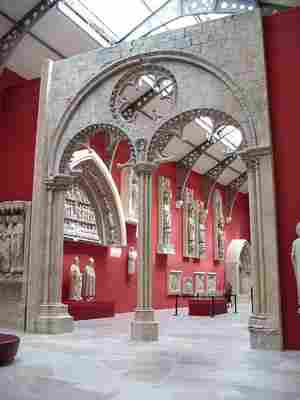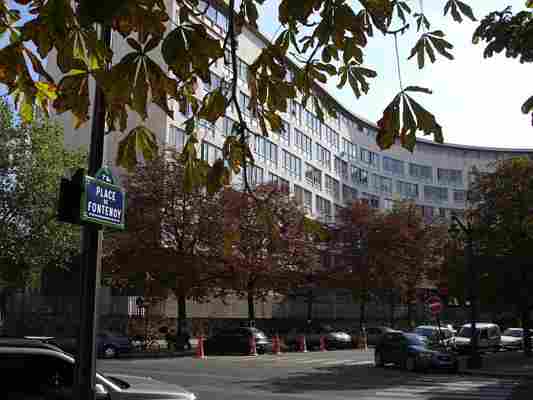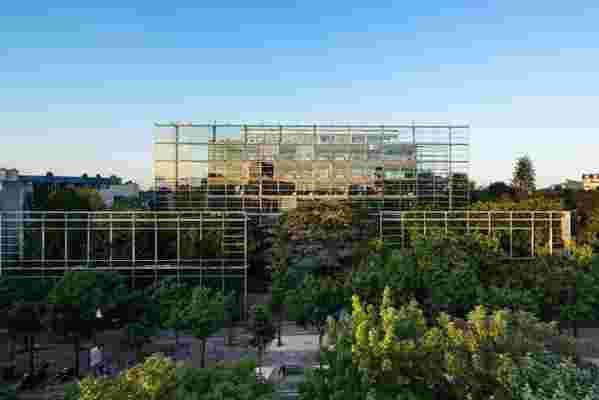On a visit to Paris, great architecture is about as easy to find as great steak frites: It’s everywhere, and even the so-called bad stuff (ahem, Tour Montparnasse) is good in its own right. But, just as in the world of fine dining, a bit of research goes a long way in uncovering some of the city’s most extraordinary buildings—there’s a lot more to Parisian architecture than the Tour Eiffel or the Arc de Triomphe. For those visiting the French capital, or just dreaming about it, AD has rounded up some of our favorite buildings, monuments, and even interiors that are often passed over in favor of their more famous neighbors.
This content can also be viewed on the site it originates from.
La Maison de Verre, Pierre Chareau
Designed by Chareau in 1931, La Maison de Verre has long reigned as one of the most exclusive and treasured architectural marvels in Paris. A study in early modern design, the house has neatly partitioned geometries rendered in a mix of industrial materials like steel, glass (hence the name), and rubberized flooring. Though the home is in private hands, a limited number of tours are granted each year to those working or studying in the field of architecture.

Galeries des Moulages, Musée de L’Architecture et du Patrimonie
The Galeries des Moulages at the Musée de L’Architecture et du Patrimonie is a pilgrimage for even the most discerning architecture enthusiasts. Situated on the museum’s ground floor, the galleries contain more than 350 ornamental and structural plaster casts and some 60 models, all displayed against the space’s cherry-red walls to dramatic effect. Perhaps the crown jewel is a cast of the painstakingly detailed facade of the Romanesque Moissac Abbey.

UNESCO Headquarters, Marcel Breuer, Pier Luigi Nervi, Bernard Zehrfuss
The UNESCO headquarters as we know it, which opened in 1958, was the joint effort of three famous modern architects, notably of three distinct nations: the United States’ Marcel Breuer, Italy’s Pier Luigi Nervi, and France’s Bernard Zehrfuss. A modern tour de force, the aptly nicknamed three-point star is located just south of the Eiffel Tower in an otherwise quiet residential neighborhood. Guided tours of the UNESCO campus, which contains several other structures, are available to the public.

Fondation Cartier Pour L’Art Contemporain, Jean Nouvel
Completed in 1994, the Fondation Cartier’s Jean Nouvel–designed home sits on the city’s Left Bank, not far from favorite tourist destination Les Catacombes. The lushly tree-lined building is Nouvel at his finest, offering an inside-out transparency that fully embodies the foundation’s mission to bring public awareness to the often insular world of contemporary art. Architecture enthusiasts will be enticed by the site’s architecture tours, which are on offer one Saturday each month and must be booked in advance.
Villa Savoye, Le Corbusier and Pierre Jeanneret
Just a quick drive or RER ride outside the city limits, Le Corbusier’s Villa Savoye offers visitors a quintessential education in all things Le Corbusier, showing off the architect’s Five Points manifesto. The iconic white reinforced-concrete residence, which was built between 1928 and 1931, is now open to the public year-round.
Grande Arche, Johann Otto von Spreckelsen
To call the Grande Arche “hidden” is not entirely true: von Spreckelsen’s oversize modern arch is a defining—if not the most defining—feature of Paris’s La Defense neighborhood. It is hidden, however, to the average tourist who might not ever make it to the city’s western edges. The Arche was built in 1989 to recognize the bicentennial of the French Revolution.
Maison Louis Carré, Alvar Aalto
Located some 40 kilometers outside of the city, Aalto’s Maison Louis Carré has been lauded as the architect’s most important residential work. Commissioned in 1956 by then-famous art dealer Louis Carré, the house was designed as a hybrid art installation-private residence. Aalto’s signature is subtly presented throughout the home, particularly in the gently sloping roof and visible wooden louvers. Today the residence is open the public from March through November.